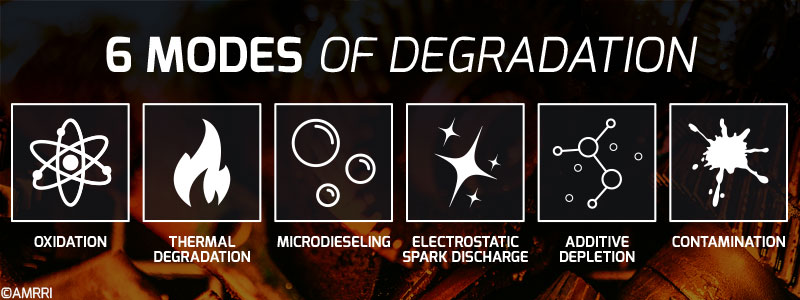
Oxidation
The most common form of degradation is oxidation. While this is the most recurrent form of degradation, the term is often misused to describe all forms of degradation. During Oxidation, a free radical is formed, which is highly reactive. Its primary purpose is to create other free radicals which can attack the base oil.
However, lubricants have been formulated with antioxidants. These knights in shining armor react with the free radicals to neutralize them and protect the base oil. As such, during the oxidation process, one will notice a decline in the concentration of antioxidants typically evaluated using the RULER® (Remaining Useful Life Evaluation Routine) test.
Eventually, the antioxidants become depleted, and the free radicals begin attacking the base oil. During this stage, polymerization can occur, which leads to the formation of deposits within the lubricant. Not every deposit is chemically similar.
The deposit will gain its characteristics from its environment and the products present during the chemical reaction. When these deposits occur, they can get lodged in the smaller clearances (particularly servo valves), which leads to possible malfunctioning of the equipment. Due to the nature of lube oil varnish, it can act as an insulating layer that increases the temperature throughout the equipment.
Thermal Degradation
Another form of degradation is called thermal degradation. As its name suggests, heat is one of the environmental conditions required for this degradation mechanism. During thermal degradation, the oil can experience temperatures over 200°C.
The Arrhenius equation is one of the industry’s rules of thumb whereby for every 10°C rise over 60°C, the life of the oil is essentially halved. At 200°C, the oil is cooked and produces carbon-based deposits, which is this mechanism’s characteristic type of deposit. The FTIR (Fourier Transform Infrared) test is instrumental in identifying the presence of these deposits.
Microdieseling
One can argue that microdieseling is a form of thermal degradation and should be classed as such. However, during microdieseling, air becomes entrained in the oil and moves from a low-pressure zone to a high-pressure zone.
If the oil does not have good air release properties, then the entrained air will not make its way to be dissipated at the surface. This entrained bubble in the oil can cause temperatures to rise to 1,000°C.
The bubble interface usually experiences some carbon accumulation and then implodes. This can be through a high implosion pressure which results in soot, tars, or sludge, or through a low implosion pressure which can form carbon insolubles such as coke, tars, or resins.
Electrostatic Spark Discharge
Electrostatic spark discharge may be classified under thermal degradation as it involves temperatures over 10,000°C. During this mechanism, oil builds up static electricity at a molecular level when the dry oil passes through tight clearances in the equipment.
Eventually, the static will build to a point where it produces a spark, and free radicals are formed. This can lead to uncontrolled polymerization producing varnish, sludge, or other insoluble materials. One of the tell-tale signs of this mechanism is the presence of burnt patches of membranes on the filters.
Additive Depletion
Additive depletion is often a form of degradation which gets left behind. As stated earlier, additives are sacrificial and will be depleted over time. Their purpose is to protect the lubricant and the machine, but they can be significantly depleted in some instances, leaving them vulnerable.
This type of degradation can produce two types of deposits, organic or inorganic. During degradation, rust and oxidation additives can become reacted with other components. These types of reacted additives can form organic deposits.
Alternatively, inorganic deposits such as ZDDP (Zinc dithiophosphate) can deplete and form a tenacious layer. The Depletion of ZDDP will impact the wear rate as this is the antiwear additive.
Contamination
Often, the most unrecognized form of degradation is contamination. Some may argue that this is not a form of degradation. On the contrary, this degradation mode can be the initiator for other mechanisms such as oxidation, thermal degradation, or even microdieseling.
Essentially, contamination occurs when foreign material is present in the lubricant. Often, this foreign material can become a catalyst for one of the other forms of degradation. Therefore, it must be acknowledged separately, as only the degradation mode can be eliminated by removing the contaminant.
Want to read the entire article? Find it here on Precision Lubrication Magazine!




